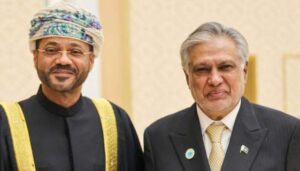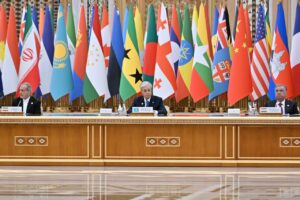Victory Wears Many Colours

Air shows are important to put forward the air force’s technological prowess and readiness. They are used as a medium for strategic storytelling. As a platform, they enable air forces to commemorate and communicate their mastery of the skies and lethality at a global stage. The Royal International Air Tattoo (RIAT), since 1971, has forged its legacy by being recognised as the world’s largest military air show, held annually at RAF Fairford in the UK. The Pakistan Air Force (PAF) took part in the RIAT- 2025 with a contingent of four aircraft.
PAF after striking a 7-0 victory against the Indian Air Force (IAF) through its application of multi-domain operations (MDOs) during operation Zarb-e-Karar, won big at RIAT. In a competition in which 27 air forces with 220 aircraft participated, PAF claimed 2 awards. JF-17 Thunder Block III was awarded with the “Spirit of the Meet” in recognition of PAF’s efforts to deploy two of these specially painted indigenous aircraft on a 6000 km journey alongside air refueller II-78 and a transport aircraft C-130H. It is worth noting that apart from winning the trophy, PAF demonstrated its strategic airlift and reach capabilities. This highlights that PAF is a force fully abreast with the requisite will and mechanism to live by its vision ‘second to none’ as envisioned by the Quaid e Azam Muhammad Ali Jinnah.
The PAF’s second win at RIAT was the Concours d’Elegance RUAG Trophy, awarded due to the stunning livery of the “Eyes in the Sky” theme on the C-130H. The mighty Iqbal’s Shaheen was painted on the nose of the aircraft, while the tail displayed powerful imagery representing multi-domain operations. More than mere artistry, this was a display of the PAF’s prowess and its ability to operate across all domains. The artwork provided strategic storytelling of the PAF brilliance, sharp-eyed, far-reaching, and prepared for the future. The victory was especially meaningful, as it transformed battlefield dominance into a magnificent display of excellence before the world. As the saying goes, ‘victory wears many colours’. It appeared to be a natural extension of battlefield reality. The world had witnessed the PAF’s application of multi-domain operations, leaving both allies and adversaries in awe. Now they had seen the PAF’s professionalism expressed through the language of aesthetics. Personally, it was a moment of immense pride, having served as a member of PAF No. 8 Squadron, which brought honour to the nation when its JF-17s won the ‘Spirit of the Meet’ trophy.
By winning these awards, the PAF has cultivated a soft image while reaffirming its reputation as a measured, dignified, and strategic force. The Indians, who aspire to be the region’s ‘net security provider’, were conspicuously absent. In my reckoning, the IAF chose to avoid RIAT because the presence of the PAF would have served as a bitter reminder of how it lost its pride, dignity, and sovereignty in the South Asian skies. Moreover, the JF-17’s superiority would have shattered every myth the Indians hold regarding the LCA Tejas. Owing to its limitations for complete deployment, LCA Tejas can only serve Mr Modi as a symbol for his election campaign, but it stands no chance in the realm of real world.
The JF-17 was not merely in the spotlight; it owned it. It stood as a symbol of excellence and credibility on one of the world’s most prestigious aviation stages. Young pilots from around the world, many of whom operate advanced fourth and fifth-generation aircraft, were deeply impressed by the JF-17 Block III’s capabilities, particularly its digital connectivity, avionics and its ammunition.
Indeed, the PAF has won hearts and minds. The accolades have brought pride, and Pakistan has reclaimed its place in the global discourse as ‘a force to reckon with’. However, the most compelling takeaway is the PAF’s ability to deploy its assets thousands of kilometers from home, placing it among the leading air forces in the world with strategic flexibility and operational reach. Only a handful of nations possess such a formidable air force, one that has responded to every challenge with resolve and risen with grace in every competition. The UK Air Chief, Sir Richard Knighton, has commended the PAF for its professionalism, proven success, and outstanding RIAT. Once again, it stood as a testament to the PAF’s commitment to excellence, technical expertise, and unwavering pursuit of distinction.
Looking at the PAF’s performance in recent months, one can conclude that ‘victory has a rhythm’. Yet, reaching such a rhythm requires finding the right tempo. This tempo has
been expertly set by the composed and visionary leadership of Air Chief Marshal Zaheer Ahmed Babar Sidhu. Had it been any other challenge or competition, the PAF would still have delivered the same result. May Allah keep the PAF under His protection and safe from evil eyes, as its success continues to arrive one after another.

